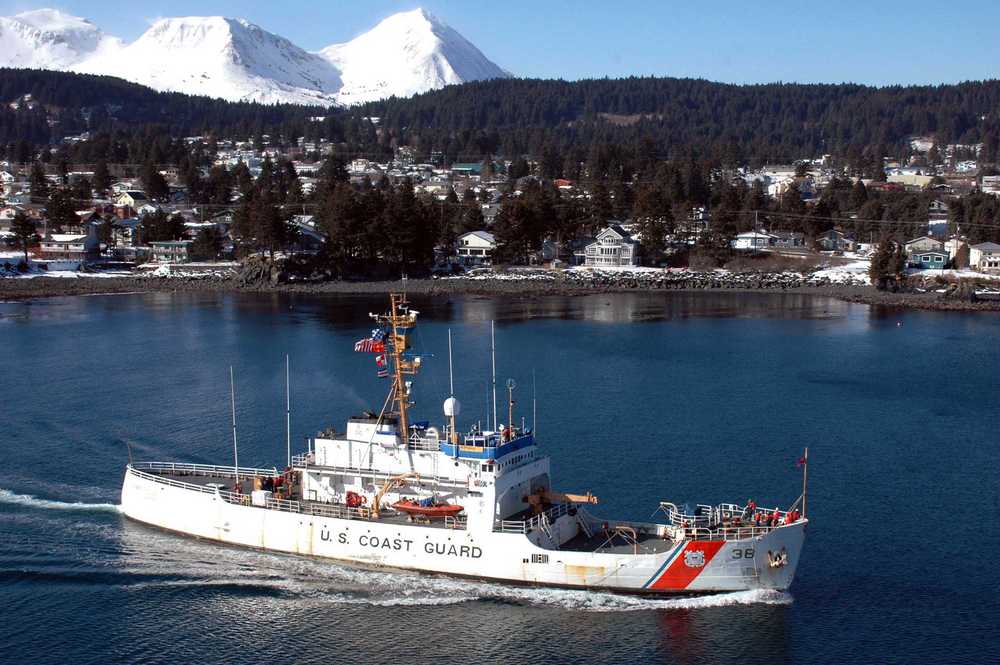The U.S. Coast Guard Cutter Storis was a military ship that served witness to World War II, the Cold War, the 1964 earthquake that rattled Alaska, Exxon Valdez, North Pacific fisheries enforcement, and scores of high seas rescues. The stories of the Storis are varied, numerous, and impressive. That we haven’t heard more about this amazing ship is surprising.
Local Juneauite Damon Stuebner has finally brought the Storis to light through his documentary called, “STORIS: The Galloping Ghost of the Alaskan Coast.” “STORIS” will play four shows at the Gold Town Nickelodeon Theatre starting March 20.
On a snowy night nearly a decade ago, Stuebner was approached by a member of the Alaska Historical Society. They were working with a group to save some “old Coast Guard cutter.” Stuebner was asked to make a video about the history of the ship. (Stuebner earned a degree in communications with an emphasis in journalism and worked as a photojournalist and news videographer in Pennsylvania and Alaska).
Steubner didn’t have the time. He and his wife had just bought a house, but he eventually agreed. As Stuebner says about the his current state of affairs seven years later, “our master bathroom is still not finished, but we now have a documentary!”
The Storis and Stuebner share something. The history of the cutter is a history of perseverance; never stopping, sailing into rather than away from the storm, and plowing through ice sheets. No doubt Stuebner himself showed a great deal of perseverance. To see a good idea through requires a necessary internal grit to work and work until the project is done. Great works are not a function of good ideas. There are millions of good ideas. They are a function of perseverance.
Over seven years, scrapping for time and money, Stuebner stitched together this documentary. There were trips to the military’s ghost shipyards of San Francisco. There was travel to the National Archives and U.S. Coast Guard Historian’s Office in Washington D.C. Stuebner interviewed veterans who served on the Storis, and sifted through hours of footage and pictures from museums, archives and personal collections.
And why not? The Storis’ story is incredible. In fact, according to Stuebner, one of the great challenges of building this story was figuring out what not to include.
For 65 years, the Storis plied the waters of the Arctic. She was built in the run up to World War II. Set afloat in 1941, the Storis went to work off the coast of Greenland six months before the bombing of Pearl Harbor. A few years later, the Storis transported troops instrumental in capturing Nazi soldiers manning weather stations on the island.
In 1948, the Storis was transitioned into a peacetime vessel. She was stationed in Juneau for 10 years. Alaska was a territory at the time, and the federal government used the Storis to ship goods like mail, and services like dentists, to villages up and down the Bering Sea coast.
In the early 1950s, the Storis became part of Cold War history. She helped in the development of the DEW Line. DEW stands for Distant Early Warning, and the DEW Line was a series of radar installations across Alaska and northern Canada. The stations provided early warning to the U.S., should Soviet bombers attack by flying over the North Pole. The DEW Line was far enough north to allow the U.S. military time to scramble a response. During construction of the DEW Line, the Storis used its ice breaking capabilities to lead supplies boats into the frozen waters of Canada’s arctic archipelago. In doing so, this unassuming cutter became the first U,S, ship to transit the Northwest Passage.
Another unusual aspect of the Cold War was its impact on fishing enforcement. By 1958, the Storis was stationed in Kodiak. For the next 40 years the cutter participated in enforcing our ever-expanding exclusivity zone for fishing. Japanese trawlers were often escorted out of the area. Soviet fishing boats were also encountered. Each encounter with the Soviet fishing fleet, however minor, could quickly magnify into an international incident when viewed under the convex lens of the Cold War. With nerves on edge, reports from the Storis when boarding Soviet fishing boats were directly broadcast to Washington D.C. in real time.
Stuebner notes that the Storis was the only ship of its design. Its look was so unique Stuebner could easily find pictures of the Storis, even in unlabeled archives. He found the Storis operating in all sorts of notable events like a naval version of Woody Allen’s “Zelig.” There is the Storis pushing Cook Inlet ice out of the way of supply ships in the wake of the 1964 Earthquake. There is the Storis provided support and personnel to the Exxon Valdez response and clean up. There is the Storis saving crew from sinking fishing boats.
Alas, all good runs must end. In the 1990s, the Storis became the oldest boat in the Coast Guard fleet. With a small ceremony, the cutter was decommissioned in 2007. For 66 years the Storis forged a storied career in the rough, gray waters of the arctic.
I can’t think of a better ending than Stuebner’s own words.
“Storis really was a unique ship … I have to thank all the Storis veterans who helped me tell the story of their ship. If it were not for them allowing me into their homes, telling me their stories, sharing their scrapbooks and homes movies with me, and putting me in contact with their ship mates, I doubt I would have been able to properly tell the history of the Storis.”
“STORIS: The Galloping Ghost of the Alaskan Coast” plays at the Gold Town Nickelodeon at 4:30 p.m. March 20, 7 p.m. March 21, and at 4:30 p.m. and 7 p.m. March 28.
To learn more about the Storis go to uscg.mil/history/webcutters/Storis1942.pdf and uscgcstoris.net/.
• Clint J. Farr can be reached at cjfarr@hotmail.com.

